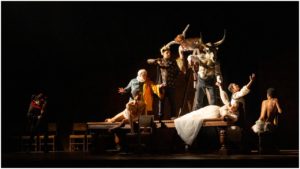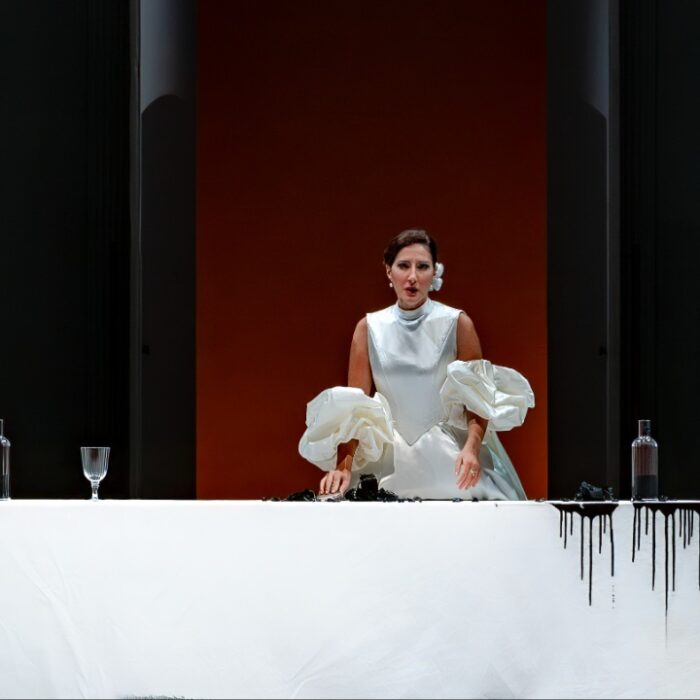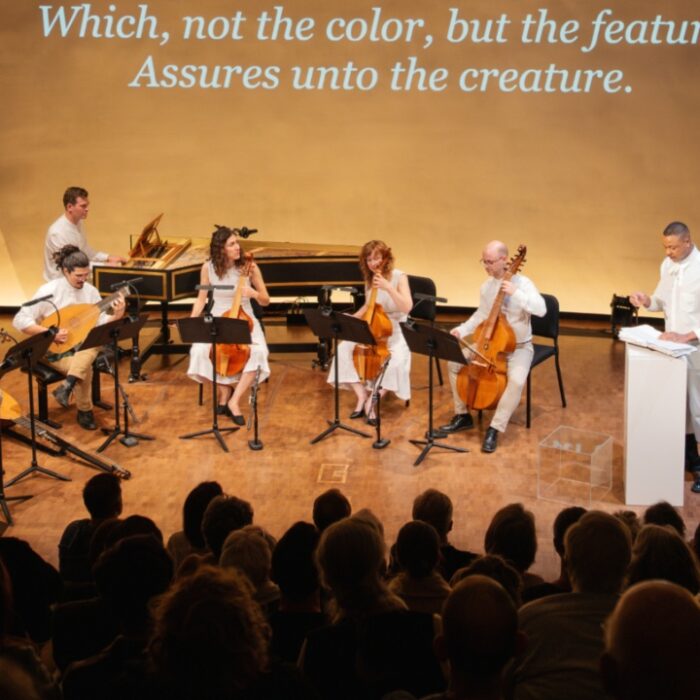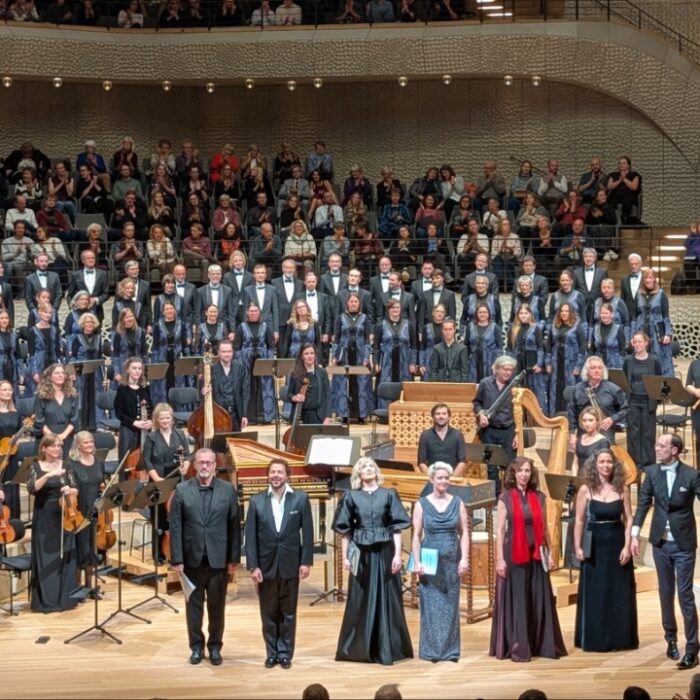
Royal Opera House 2021-22 Review: Rigoletto
Antonio Pappano, Lisette Oropesa, Carlos Alvarez Lead Insightful New Production
By Benjamin Poore(Credit: (c) ROH 2021. Ellie Kurttz)
Antonio Pappano has been at the Royal Opera House for nearly two decades, yet has never conducted “Rigoletto,” a capstone of the repertory. This would be his first performance of the work – and the opening shot of the 2021-22 season at the Royal Opera.
Another first for Oliver Mears, artistic director of the ROH, who is finally getting his feet wet with a production of his own following the beginning of his tenure in 2017. His “Rigoletto” replaces David McVicar’s stalwart show – a grimy, gloomy affair whose opening orgy ran out of steam some years ago and whose set audibly creaked.
Manipulative as Paint
The real Duke of Mantua was a patron of the arts – look out for him in one of the ROH boxes today – and Mears’ production makes this the starting point. The opera’s titular character shares something with the women used and thrown away by the Duke – their disenfranchisement comes from how they please the eye. Art is at the center of Mears’ vision of the opera. The curtain rises, after Verdi’s backlit, baleful opening, on a dazzling mise-en-scene – a real-life tableau of Caravaggio’s “The Martyrdom of St. Matthew.” The Duke, it turns out, is in the picture, and wears a skull with golden horns; the saint is substituted for Monterone’s daughter, pregnant but clad in virginal white.
The party takes place underneath Titian’s “Venus of Urbino;” it is replaced portentously in the second half by his “Rape of Europa,” lingering above the room where the Duke rapes Gilda. (The climactic reveal of Act one sees her replaced by a grotesque wooden doll, like something out of Otto Dix or Sarah Lucas). Art shapes life ever so cruelly in this “Rigoletto:” to riff on Brillat-Savarin, you are what you rate – monstrously so. Fabiana Piccioli’s tenebrous lighting emphasizes the aesthetic beats, grasping the chiaroscuro of Caravaggio’s soiled world.
People are as manipulable as paint. The Duke bullies the costumed women lined up in the first scene. Characters take on the grandiose and bizarre gestures of the very artworks he loves. Monterone suffers a spectacular, horrific eye-gouging and then is bathed in light and dry ice; Marullo and Ceprano stage a queer-coded dumb show reenacting the abduction of Gilda in Act two (perhaps a long-range play on Caravaggio’s own sexually complex portraiture).
In the first scene, the Renaissance-chic costumes give way to modern dress. Ilona Karas’ costumes grow more understated and elegant as the show progresses: a dour homburg and coat for Rigoletto; a chaste-yet-sensuous white shift for Gilda; the only dull note was the Duke’s jacket in Act three, which made him look a little short, rather impeding his priapic energies.
The paintings give way – as does Sparafucile’s inn, somewhat indiscreetly crawling offstage – in the final scene to water and clouds (the latter burst rather spectacularly with real rain during the climactic storm.) A muddy, troubled world sits behind the Duke’s realm of sculpted appearance – but one through which light glimmers, one cleansed – perhaps – by the storm and Gilda’s sacrifice. Act two takes place below Gilda’s glowing bedroom cutaway on a bare stage, colored a decaying ochre and umber, like the surface of a dirty oil painting. Simon Lima Holdsworth’s design pushes, for the most part, the right tonal buttons.
The first half is certainly atmospheric enough, and the prevailing theme is a promising one, though feels increasingly incidental as the show goes on. Relative spareness meant chill as well as evocation.
However, some blocking was dramatically awkward – even a little old-fashioned (do tenors really need to sink to their knees these days at the heights of the Duke’s Act three aria?) In the quartet, Rigoletto and Gilda were facing downstage rather than up so could scarcely watch the Duke seduce Maddalena; the duke perused two prints of paintings he seems to already own in Act two – one wonders why. Such moments will surely be evened out in revival – next February – which will help pump the thematic and emotional blood into the show’s extremities.
Glittering Cast
Mears and Pappano had a glittering cast to back them up. With a few wobbles, they delivered to the highest standard. Carlos Álvarez still delivers a powerful baritone with depth and definition all the way down, though took a more understated approach across the evening, eschewing some of the interpolated high notes; the ones he did go for though – the top G in the “Cortigiani” sequence – certainly thrilled.
Even if he did sometimes drift a little flat, his performance found its emotional feet in the great pleading legato that defines so much of the role. This was especially true as he begged Marullo – hopelessly – for pity in Act two, crawling across the stage on his knees. The very final notes of the opera were less histrionic than usual, which robbed the climax of its musical gut punch, but elsewhere Álvarez brought a careworn, broken quality to this most Lear-like of roles.
Lisetta Oropesa remains one of the leading lyric coloraturas working today. There is richness and oaky color in her lower register – redolent of Callas – which gives the character a power and gravitas that twittering glittering approaches rule out. Her “Caro nome” received a thunderous reception, and most of the passagework and high notes shone – particularly that trill – though intonation at the very top did waver somewhat. Most thrilling was the climax of the aria, so to speak, that saw her recline on the bed and caress herself – a great character moment for one that can come over, too often, as tediously pious. Her Act two lament was achingly lyrical.
Liparit Avetisyan made a stellar impression as the Duke. His is a flexible, agile tenor that shows no strains or cracks (notwithstanding a slightly overcooked top note in “La donna è mobile”), and has a natural, inviting approach to line and phrasing.
“Questa o quella” had delicious verve, nasty as he was during the staging to Monterone’s daughter; his Act two “Parmi veder le lagrime” was riveting, a complex and compelling picture of a manipulator and rogue who nonetheless believes their own delusions, sung with commitment and richness. He’s a bastard, but not inhuman. His Act one duet with Oropesa’s Gilda was another radiant highlight.
Brindley Sherratt offered a flinty Sparafucile, plumbing the depths of his bottom F without breaking a sweat (singing it while walking offstage always impresses).
Blaise Malaba and Dominic Sedgwick put in characterful turns as Ceprano and Marullo respectively; Ramona Zaharia’s Madalenna played smitten seductress well, with a velvety purr that stood up well in the quartet. Eric Greene’s Monterone sounded oddly metallic and a little washed out lower down, though was a convincing dramatic presence nonetheless.
Special mention should go to the men of the ROH Chorus, whose energy and precision showed them to be model choristers: crisp consonants placed well before the beat, a monumental sound in the great climaxes, uncanny echoes in the Act three storm. Their “Zitti, zitti” at the end of Act one was conspiratorially exact.
Antonio Pappano has kept his powder dry on this opera for many years. But he and the orchestra unleashed music-making of brilliant rhythmic energy and sculpted detail, from the explosive, searing cries of pain from the strings in the overture to the poised plangency of the Act two oboe solo.
The real heat came from the pit and from the voices – though it is a production with promise and insight nonetheless.


